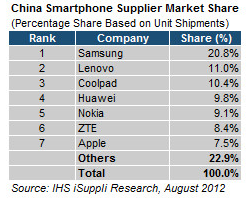Globally, Apple at least is one of the top three vendors in the smartphone market. But China is the world's only market where Apple humbles to seventh rank, according to new IHS data for the first half of 2012.
During the first half of 2012, Apple represented 5.2 million units,or 7.5 percent of shipments of smartphones for sale in China. This was only about one-third of the share held by Samsung that leads the pack with 20.8 percent of shipments. Lenovo, Coolpad, Huawei, Nokia and ZTE all ran ahead of the American vendors; Motorola, and Sony.
The IHS report blamed the Apple's humble place for the iPhone's limited availability for the China's mass consumers. ".Among all the international smartphone brands competing in China, Apple is the only one not offering a product that complies with the domestic TD-SCDMA air standard,” noted Kevin Wang, director of China electronics research at IHS.
Network Access License for TD-SCDMA Terminal Information System

Apple’s iPhones are run both on 2G and 3G networks by China Unicom and China Telecom. But iPhones do not operate in China Mobile’s 3G network. “For Apple, this is a huge disadvantage, as TD-SCDMA represents the fastest-growing major air standard for smartphones in China, with shipments of compliant phones expected to rise by a factor of 10 from 2011 to 2016.”.
By snubbing TD-SCDMA, Apple loses the chance to sell the iPhone to some of 650 million pepole who are subscribers of China Mobile. Apple's deals with the country’s No. 2 and No. 3 carriers, China Unicom and China Telecom as distributors, give it access to 34% of the market.
In contrast, Samsung has played with the TD-SCDMA small guys into the price-conscious market. Samsung has a wider access than Apple, as it already offers several smartphone models that work in China Mobile’s 3G networks. A recent Gartner report suggested that Samsung's wide availability in China deserves the credit for its success in China.
However, Apple is still unlikely to move into the TD-SCDMA market, whose 3G conversion is marginal.

Apple is seldom motivated to develop a TD-SCDMA version of iPhone. Adding TD-SCDMA support to the iPhone should be costly process of integrating new power amplifiers, antennas and filers, as well as preparing the proper Qualcomm chip--all would end up with a lousy iPhone.
Although China Mobile holds the key for Apple to increase its access, Apple’s strategy has always been to play its own game instead of following the market. It takes the approach that we stays above the low-end market that grows in thin-margin, volume sales, Apple usually waits for several generations of products to pass and increase market share before it seeks newer late majority customers.
Likewise, Apple takes this strategy in China that it stands above the hot-pot competition among China's home-grown vendors who aggressively expands the smartphone sales at a deeply-discounted prices.
The IT community is therefore is doubtful of speculation about a TD-SCDMA version of Apple iPhone to appear targeting China Mobile subscribers when Apple launches next genration of iPhone 5 later this year.
Although it stays away from the game of the TD-SCDMA guys, analysts have said, Apple should join China Mobile's camp when China Mobile begins the rollout of the TD-LTE (4G) network in 2013.
China Mobile hopes the new TD-LTE will be a multi-mode, multi-frequency modem strategy that will turn around its earning drop. During the first half of 2012, Its corporate earnings and average revenue per user (ARPU) dropped in its low 3G conversion.
The new TD-LTE modem must operate on TD-SCDMA and GSM inside China, while it also offer roaming capability on 4G and FDD as well as 3G and WCDMA. The TD-LTE phones will become interoperable with 2G, 3G and 4G networks anywhere in the world.
Strategy Analytics says China will become the world's largest market for shipment of TD-LTE with 26 million Chinese subscribers to TD-LTE forecast by 2014.

